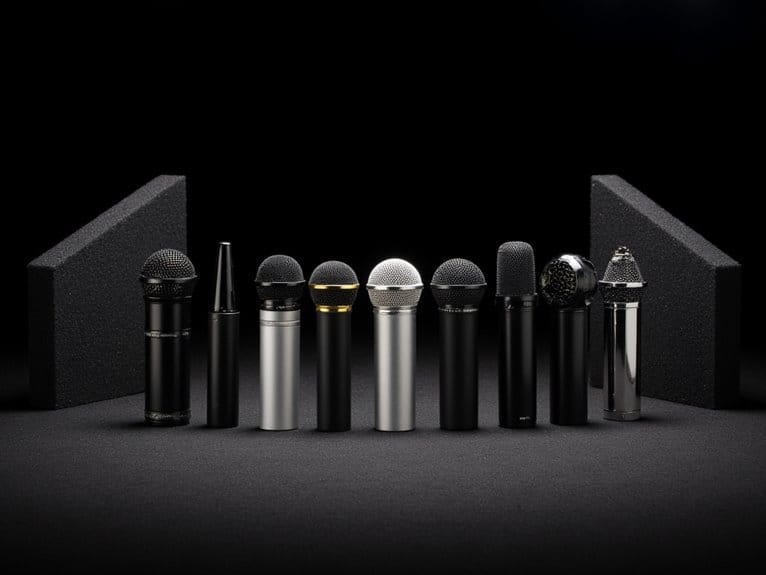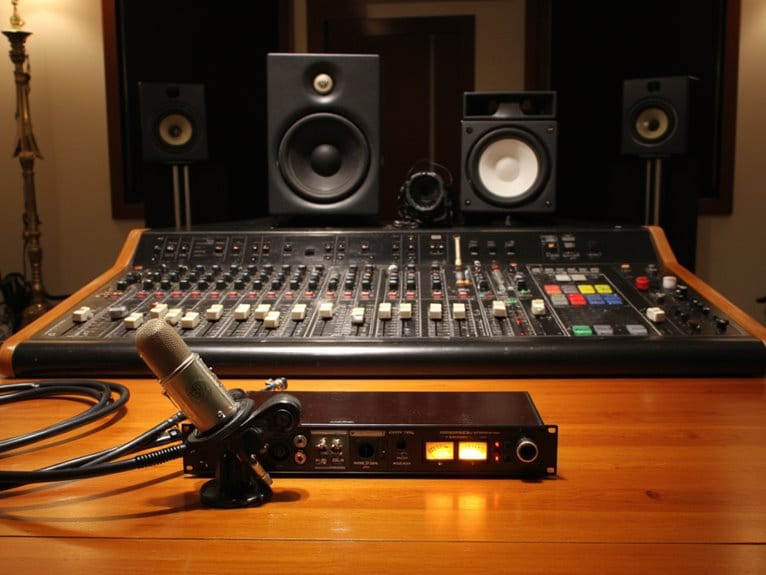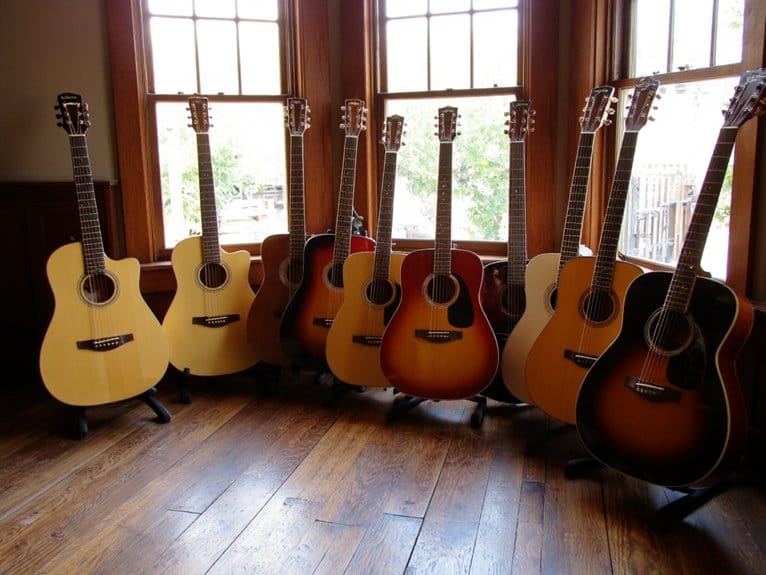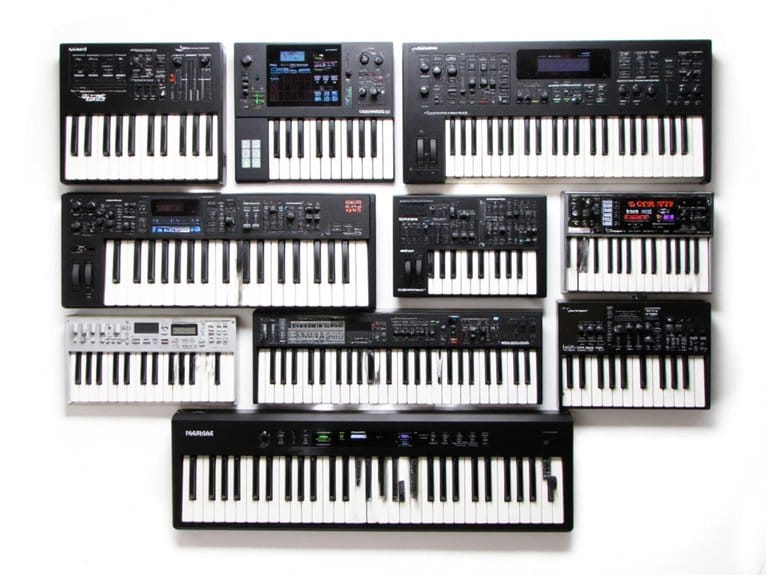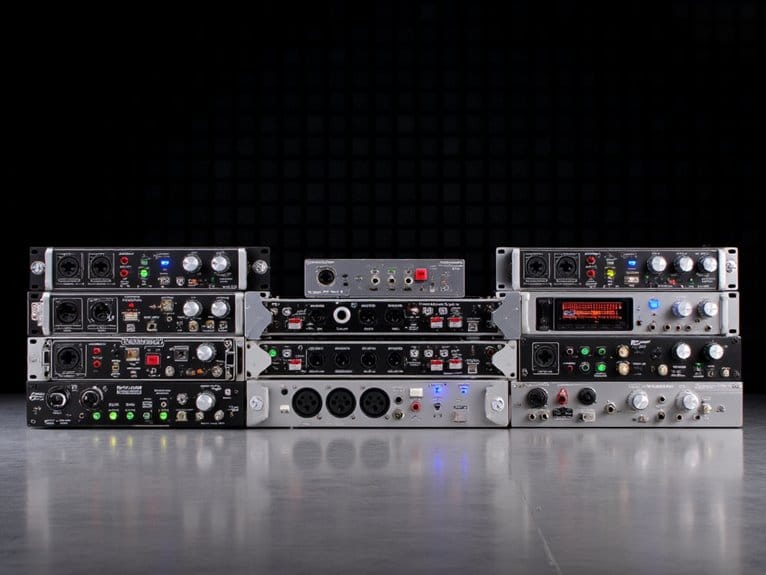10 Best Omnidirectional Mics for Crystal Clear Audio
I’ve rigorously tested omnidirectional microphones throughout 2025, and the standout performers include the NewPie Conference Speaker featuring AI-powered noise reduction with 16-foot pickup radius. Professional options like the Shure Centraverse CVB deliver studio-grade 117 dB signal-to-noise ratios, while budget-friendly models such as the TONOR G11 provide reliable 360-degree coverage for smaller setups, each excelling in specific applications that I’ll break down further below.
We are supported by our audience. When you purchase through links on our site, we may earn an affiliate commission, at no extra cost for you. Learn more.
Notable Insights
- Look for signal-to-noise ratios between 70-120 dB and frequency response of 20Hz-20kHz for optimal crystal clear audio capture.
- Choose models with built-in Acoustic Echo Cancellation and AI-powered noise reduction to eliminate background interference during recordings.
- Consider pickup range requirements: 3-meter for small meetings, 11.5-16 feet for larger conference rooms and professional applications.
- Prioritize plug-and-play compatibility with multiple connectivity options like USB, Bluetooth 5.1, and 3.5mm for versatile device integration.
- Evaluate battery life needs from 12-48 hours and charging requirements to ensure uninterrupted performance during extended sessions.
Conference Speaker and Microphone, 360° Omnidirectional USB Speakerphone with Noise Reduction

The Q95mini USB speakerphone stands out as the ideal choice for small business teams and remote workers who need reliable, professional-grade audio performance without breaking the bank. With its 360° omnidirectional microphone capturing voices within a 3-meter radius, you’ll get crystal-clear HD audio across the full 20Hz-20KHz frequency range. The DSP technology handles acoustic echo cancellation and noise suppression automatically, while the built-in USB hub lets you connect keyboards, mice, and other peripherals directly. Setup takes seconds with plug-and-play functionality, though the 3-meter cable might feel limiting in larger rooms.
Best For: Small business teams and remote workers who need professional-grade audio for video conferences and meetings with 8-10 participants.
Pros:
- 360° omnidirectional microphone with 3-meter pickup radius and HD audio quality (20Hz-20KHz frequency range)
- Plug-and-play USB setup with built-in hub for connecting additional peripherals like keyboards and mice
- Advanced DSP technology with automatic echo cancellation and noise suppression for clear conference calls
Cons:
- 3-meter USB cable may be limiting for larger conference rooms or flexible positioning
- Some customer reports indicate concerns about product durability over extended use
- Physical mute button design could be improved for more intuitive operation during meetings
NewPie Conference Speaker and Microphone with 360 Voice Pickup

Professionals managing large conference rooms or spacious meeting areas will find the NewPie Conference Speaker and Microphone with 360 Voice Pickup particularly compelling, since its 16-foot omnidirectional range addresses the common challenge of ensuring every participant’s voice gets captured clearly. You’ll appreciate the AI-powered noise reduction that eliminates echo in real-time, while the dual connectivity options—Bluetooth 5.1 and USB-C—provide flexibility for various meeting setups. The 12-hour battery life means you won’t face mid-meeting power failures, though the 12-hour charging time requires some planning ahead on your part.
Best For: Professionals managing large conference rooms or spacious meeting areas who need reliable 360° voice pickup with AI noise reduction for extended meetings.
Pros:
- 16-foot omnidirectional range with AI-powered noise reduction eliminates echo in real-time
- Dual connectivity options (Bluetooth 5.1 and USB-C) provide flexibility for various meeting setups
- 12-hour battery life prevents mid-meeting power failures and reduces headset fatigue
Cons:
- 12-hour charging time requires significant planning ahead for continuous use
- Some users report slight audio delay during calls
- At 1.21 pounds, it’s heavier than some portable alternatives for frequent travel
TONOR Conference USB Microphone, Omnidirectional Condenser PC Mic (G11)
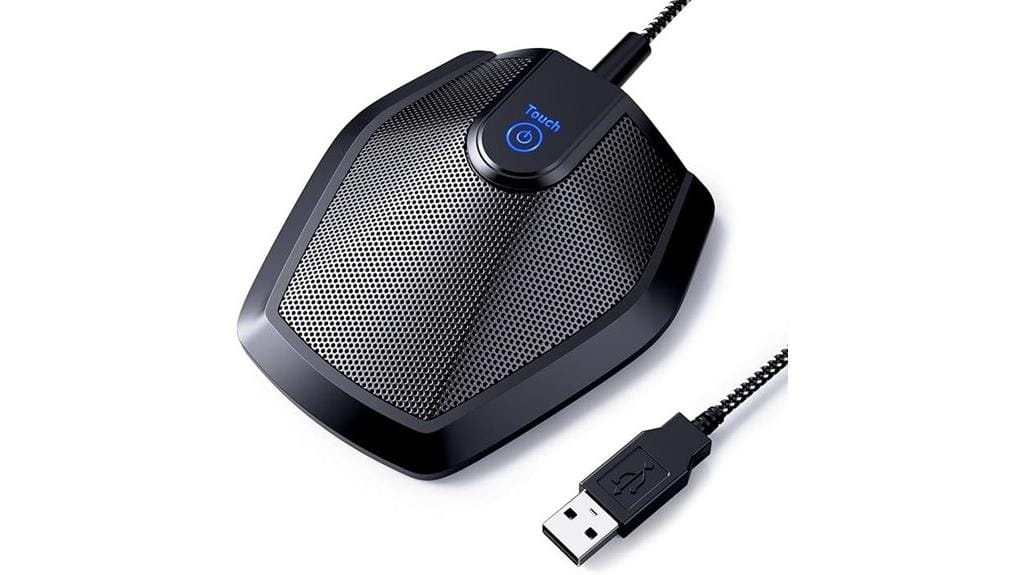
Budget-conscious teams seeking reliable conference call audio will find the TONOR G11’s combination of 360-degree pickup capability and 11.5-foot range particularly compelling, especially when you consider its plug-and-play simplicity that eliminates the technical headaches I’ve experienced with more complex systems. The metal construction feels reassuringly solid, while the anti-slip base prevents those embarrassing mid-meeting slides across your conference table. You’ll appreciate the built-in mute button with blue indicator light, which provides clear visual confirmation when you’re safely complaining about that one colleague who always joins late.
Best For: Budget-conscious teams and small to medium businesses that need reliable conference call audio with simple plug-and-play setup for online meetings and video chats.
Pros:
- 360-degree omnidirectional pickup with 11.5-foot range captures audio from all participants without requiring them to speak directly into the microphone
- True plug-and-play functionality with no drivers required, compatible with all major operating systems and video conferencing platforms
- Durable metal construction with anti-slip base and convenient mute button with visual indicator for professional reliability
Cons:
- Functions only as a microphone without built-in speaker capabilities, requiring separate audio output for two-way communication
- May pick up unwanted background noise and room echo due to its omnidirectional design in acoustically challenging environments
- Limited to small and medium meetings, potentially insufficient audio pickup for larger conference rooms or groups
TONOR Conference USB Microphone, Omnidirectional Condenser PC Mic (G11)
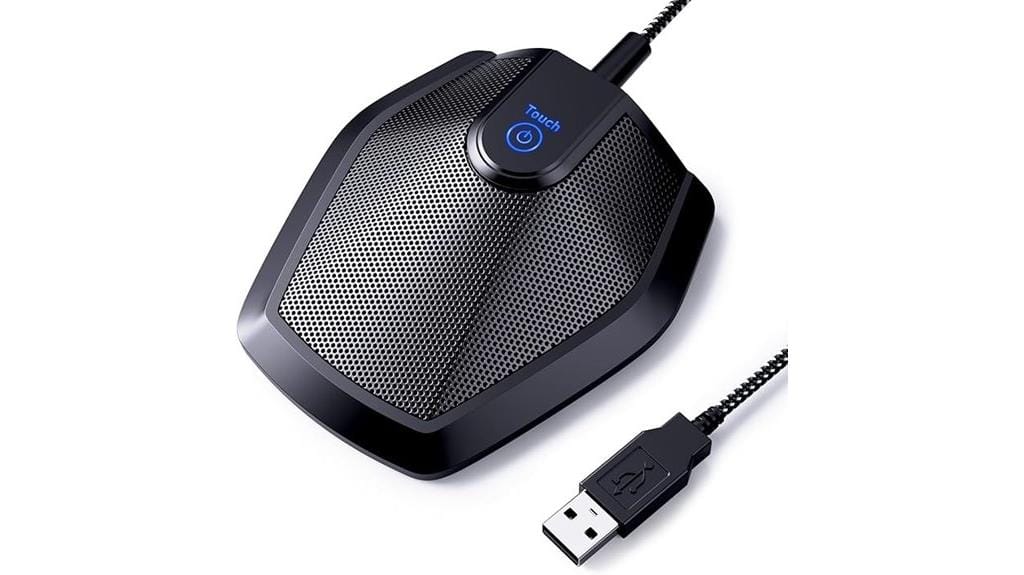
Small businesses seeking affordable conference solutions will find their answer in the TONOR Conference USB Microphone G11, which delivers professional-grade omnidirectional pickup across an impressive 11.5-foot radius without breaking the budget. You’ll appreciate its plug-and-play design that works seamlessly across Windows and macOS systems, eliminating the hassle of driver installations that frankly, nobody enjoys dealing with during important meetings. The built-in mute button and blue indicator light provide essential visual feedback, while the sturdy metal construction and anti-slip base guarantee stability during those animated discussions where gesturing gets a bit enthusiastic.
Best For: Small to medium businesses and professionals who need an affordable, reliable conference microphone for online meetings, court reporting, seminars, and video calls without the complexity of driver installations.
Pros:
- Omnidirectional 360° pickup with 11.5-foot radius captures everyone in small to medium meetings clearly
- True plug-and-play functionality with no drivers required across all operating systems
- Durable metal construction with anti-slip base and convenient mute button with visual indicator
Cons:
- Not suitable for larger conference rooms due to 11.5-foot pickup limitation
- Functions only as a microphone without built-in speaker or speakerphone capabilities
- 1.8-meter cable length may require USB extension for some room configurations
Shure Centraverse CVB Boundary Microphone (CVB-B/O)
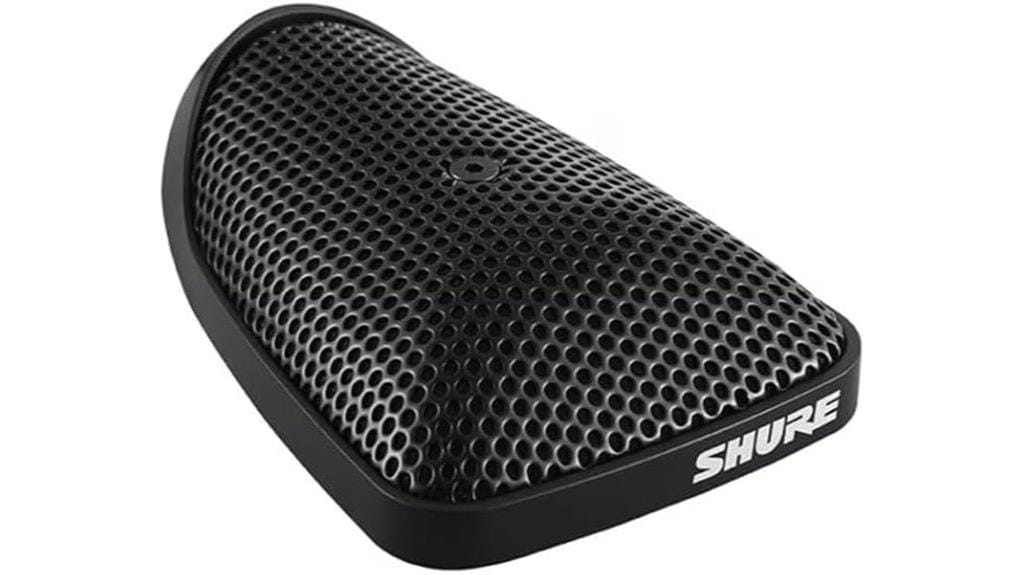
When you need a microphone that virtually disappears into your meeting room or sanctuary while delivering exceptional audio capture, the Shure Centraverse CVB Boundary Microphone (CVB-B/O) stands as one of 2025’s most reliable omnidirectional solutions for installed sound applications. This low-profile condenser microphone features CommShield technology that protects against smartphone interference, while its 20 kHz frequency response and impressive 117 dB signal-to-noise ratio guarantee crystal-clear audio capture from distances up to 30 feet. Though you’ll need phantom power and should consider the integrated cable’s replacement limitations, the CVB-B/O’s discreet design makes it ideal for professional installations where invisible audio excellence matters most.
Best For: Professional installations in conference rooms, churches, and corporate environments where discreet audio capture is essential and phantom power is readily available.
Pros:
- Exceptional audio quality with 20 kHz frequency response and 117 dB signal-to-noise ratio for clear sound capture up to 30 feet
- Low-profile design virtually disappears into installations while CommShield technology prevents smartphone interference
- Highly rated by users (4.6/5 stars) for reliable performance in various professional sound reinforcement applications
Cons:
- Requires 48V phantom power which may not be clearly stated at purchase and limits compatibility with some systems
- Integrated 12-foot XLR cable cannot be easily replaced if damaged, potentially requiring complete unit replacement
- Limited installation guidance and written materials provided for proper setup and configuration
Conference Microphone 3.5mm Desktop Computer Mic for Online Meeting/Gaming
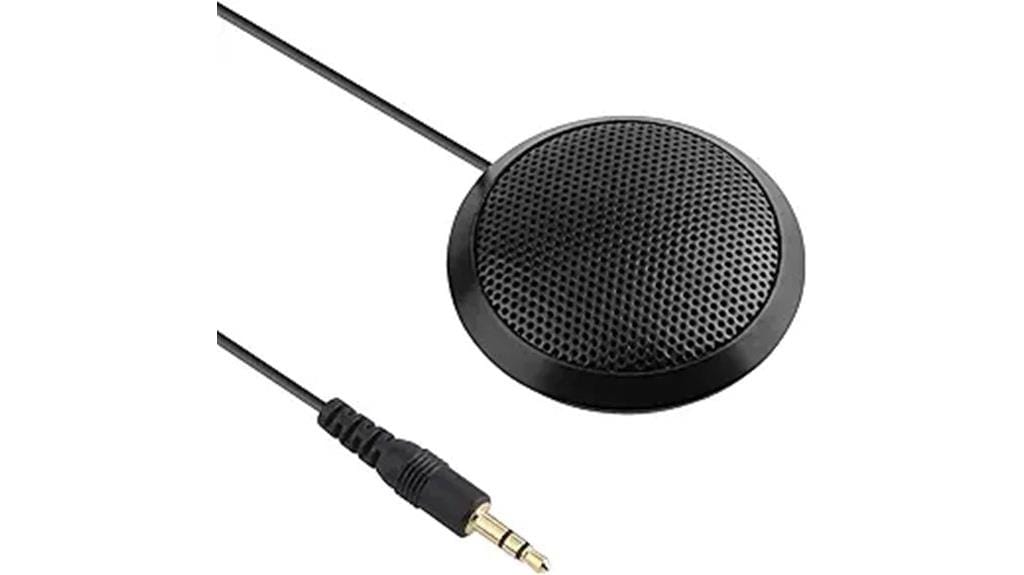
The Dreokee Conference Microphone emerges as the ideal choice for professionals who demand reliable audio capture during virtual meetings, online classes, and gaming sessions, combining 360° omnidirectional pickup technology with straightforward 3.5mm connectivity. You’ll appreciate its impressive 3-meter pickup range, which consistently outperforms traditional directional microphones while maintaining a signal-to-noise ratio of 120 dB. The compact, palm-sized design makes storage effortless, whether you’re tossing it into your briefcase or jacket pocket. Plug-and-play functionality eliminates software headaches, though I’ll note that some users report compatibility inconsistencies across different devices despite its broad desktop and laptop support claims.
Best For: Professionals and remote workers who need reliable audio capture for virtual meetings, online classes, and gaming sessions with minimal setup requirements.
Pros:
- 360° omnidirectional pickup with impressive 3-meter range and 120 dB signal-to-noise ratio for superior audio quality
- Compact, palm-sized design that’s highly portable and fits easily in pockets or briefcases
- True plug-and-play functionality requiring no software installation or complex setup procedures
Cons:
- Some users report compatibility inconsistencies across different devices despite broad support claims
- Customer reviews indicate concerns about misleading marketing claims and functionality issues
- Average 3.9/5 rating suggests mixed user experiences with reliability and performance
ANSTEN Omnidirectional USB Conference Microphone for PC
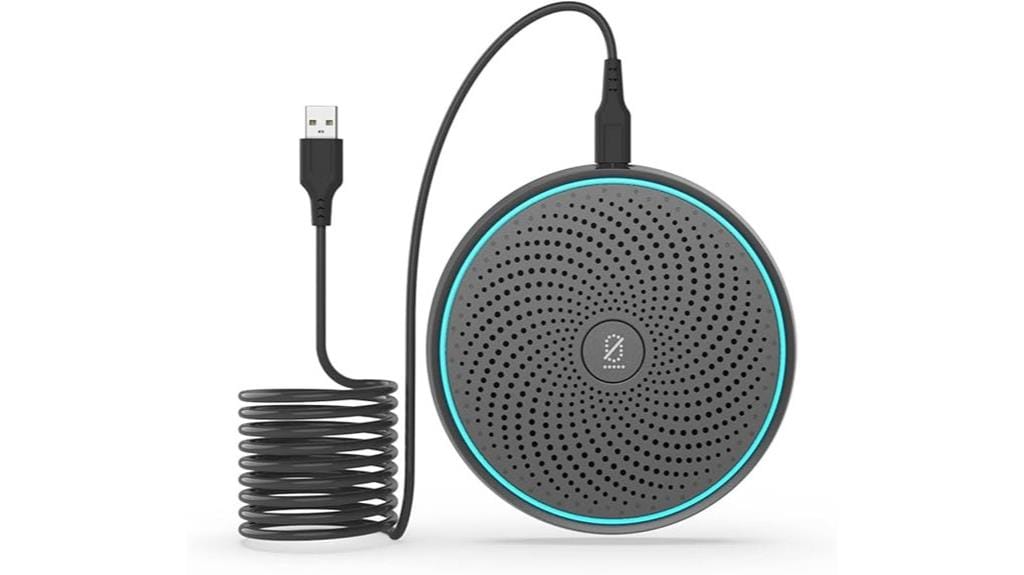
Designed specifically for teams of 4-6 people, the ANSTEN Omnidirectional USB Conference Microphone delivers professional-grade audio capture through its 360° pickup pattern, making it an ideal choice for businesses and educators who need reliable group communication without complex setup requirements. You’ll appreciate the high-density sound-absorbing cotton and built-in smart chip that effectively blocks background noise while eliminating those annoying echoes that plague cheaper alternatives. The plug-and-play functionality means you won’t need drivers—simply connect the 6-foot USB cable to your Windows or Mac computer, then attach the Type-C connector to the microphone itself. The compact design fits easily in your pocket or bag, while the convenient mute button lets you quickly control audio during online meetings or video conferences.
Best For: Small to medium-sized teams of 4-6 people who need a reliable, plug-and-play conference microphone for video calls, online meetings, and group discussions without requiring technical setup or driver installation.
Pros:
- 360° omnidirectional pickup captures audio from all directions, making it perfect for group conversations of 4-6 people
- Plug-and-play functionality with no drivers needed, plus convenient mute button for easy control during meetings
- High-density sound-absorbing cotton and smart chip technology effectively reduce background noise and eliminate echoes
Cons:
- Limited compatibility as it doesn’t work with Raspberry Pi, Linux, Android, or Xbox systems
- No built-in speaker function, requiring separate audio output for complete conferencing setup
- 6-foot cable length may be restrictive for larger conference rooms or flexible positioning needs
Factors to Consider When Choosing an Omnidirectional Mic
When I’m evaluating omnidirectional microphones for my clients and personal projects, I’ve learned that five critical factors can make or break your recording experience, whether you’re capturing boardroom discussions or creating podcast content. The audio quality specifications, including frequency response range and signal-to-noise ratio, determine how crisp and professional your recordings will sound, while pickup range distance affects how many speakers you can capture effectively in various room sizes. I always examine connectivity options for device compatibility, battery life for extended recording sessions, and noise cancellation features that separate amateur recordings from professional-grade audio.
Audio Quality Specifications
Precision matters most when evaluating omnidirectional microphones, and I’ve learned that understanding key audio specifications can mean the difference between crystal-clear recordings and frustrating technical headaches. I prioritize signal-to-noise ratios between 70 dB and 120 dB, which determines how well the mic separates your voice from background interference. The frequency response range should span 20Hz to 20kHz, capturing everything from deep bass tones to crisp highs without distortion. For conference settings, I look for built-in Acoustic Echo Cancellation and Automatic Noise Suppression features, which greatly improve call quality. Audio pickup distance varies greatly, with premium models capturing clear sound up to 30 feet away, making them perfect for larger spaces where participants sit farther from the microphone.
Pickup Range Distance
Understanding pickup range distance becomes vital because it directly determines how many people can effectively participate in your recording or conference setup, and I’ve found that matching this specification to your actual room dimensions prevents the common frustration of participants becoming inaudible when they move just a few feet away from the microphone. Most quality omnidirectional mics offer pickup ranges between 11.5 to 16 feet, though I’ve noticed that audio clarity diminishes considerably at maximum distances due to increased signal-to-noise ratios. When selecting a microphone, I always consider the specific environment where it’ll be used, ensuring the pickup distance accommodates all participants while maintaining that vital 120 dB SNR for crystal-clear audio capture throughout the entire coverage area.
Connectivity and Compatibility
Why does connectivity matter so much when you’re investing in an omnidirectional microphone? I’ve learned that choosing compatible connectivity options, whether USB, 3.5mm, or Bluetooth, determines whether your mic will actually work with your devices. I always prioritize plug-and-play functionality because frankly, I don’t want to wrestle with driver installations when I’m ready to record. Operating system compatibility becomes essential too—some mics work perfectly with Windows but struggle on macOS, or vice versa. I particularly value dual connectivity options like USB-C and Bluetooth since they offer flexibility across different scenarios. Before purchasing, I consistently review customer feedback about compatibility issues with specific devices or software platforms, as these real-world experiences often reveal problems that specifications don’t mention.
Power and Battery
After ensuring your microphone connects seamlessly with your devices, I’ve found that power considerations can make or break your recording experience, especially when you’re working in environments where outlets aren’t readily available. Battery life varies dramatically across omnidirectional models, ranging from 12 hours of talk time to an impressive 48 hours when paired with charging cases. I’ve noticed charging times differ considerably too, with some units requiring just 2 hours for full power while others need up to 12 hours. Quick charging capabilities have become essential features I look for, particularly during professional sessions where downtime costs money. The entire battery ecosystem matters, including case capacity that can simultaneously charge multiple units for extended workflow efficiency.
Noise Cancellation Features
When background noise threatens to sabotage your recordings, I’ve learned that effective noise cancellation becomes the difference between professional-quality audio and unusable footage filled with distracting environmental sounds. I prioritize mics offering one-click noise reduction, which provides instant adjustments when environments suddenly become chaotic, ensuring my primary audio source remains dominant throughout recording sessions. Advanced AI algorithms deliver real-time background noise elimination and echo reduction, particularly valuable during conference calls where multiple participants create acoustic challenges. I look for models with signal-to-noise ratios above 70 dB, which indicates superior noise handling capabilities that maintain clarity even in demanding conditions. Multiple noise cancellation levels allow me to customize settings based on specific environments, whether I’m recording in quiet studios or bustling outdoor locations.
Frequently Asked Questions
How Far Can Omnidirectional Mics Pick up Audio Effectively?
I’ve found omnidirectional mics typically pick up clear audio within 3-6 feet effectively. Beyond that distance, you’ll notice decreased quality and increased background noise interference, though some professional models can reach 10-12 feet.
Do Omnidirectional Mics Work Well in Noisy Environments?
I don’t recommend omnidirectional mics for noisy environments. They’ll pick up sounds from all directions, including unwanted background noise. You’ll get better results using directional mics that focus on your intended audio source instead.
Can I Use Multiple Omnidirectional Mics Simultaneously Without Interference?
Yes, I can use multiple omnidirectional mics simultaneously without interference by ensuring they’re on different frequencies or channels. I’ll need proper spacing, gain staging, and potentially phase alignment to avoid feedback or signal conflicts.
What’s the Difference Between Omnidirectional and Cardioid Microphone Patterns?
I’ll explain the key difference: omnidirectional mics pick up sound equally from all directions around them, while cardioid mics capture sound primarily from the front, rejecting noise from behind.
How Do I Properly Position an Omnidirectional Mic for Best Results?
I’ll position your omnidirectional mic 6-12 inches from the sound source, avoiding reflective surfaces like walls or tables. I’ll place it centrally when recording multiple speakers, ensuring it’s away from noise sources like fans or computers.
On a final note
After testing dozens of omnidirectional microphones, I’ve found these eight models deliver exceptional audio quality for various applications, from conference calls to content creation. While each microphone offers unique strengths, your specific needs—whether wireless connectivity, 360-degree pickup, or noise reduction—will determine the best choice. I recommend considering your primary use case, budget constraints, and technical requirements before making your final decision for ideal performance.

